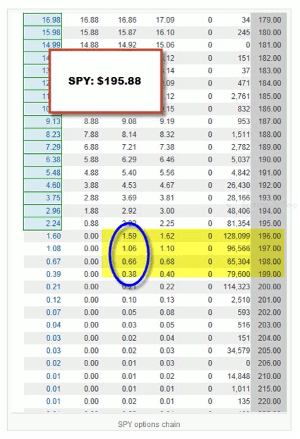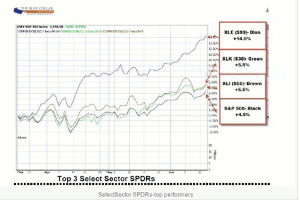Alan Ellman of TheBlueCollarInvestor.com highlights the reasons why a number of covered call writers prefer to write calls against broad market ETFs and includes the option chain for one in particular.
The initial main step for covered call writers is to select the best underlying security. This choice will vary from investor to investor based on goals and risk tolerance. Some of our members prefer exchange-traded funds (ETFs), a strategy I use in my mother’s portfolio. ETFs offer the advantages of instant diversification, less volatility (in most cases), and less management time required. The main disadvantage is the lower returns generated by these securities because of the lower implied volatility and therefore time value of the option premiums.
To keep the process even simpler, some covered call writers will write calls against a broad market index ETF like (SPY). This will give the writer exposure to the entire S&P 500 (SPX) which historically appreciates 7-10% per year. As an example, I created a screenshot of the options chain for SPY with about three and a half weeks remaining in the July, 2014 contracts:
With SPY trading @ $195.88, we will view the out-of-the-money $196, $197, $198, and $199 strikes.
We feed this information into the “multiple” tab of the Ellman Calculator to see if the results meet our goals:
With upside potential (share price moves up to strike price by expiration), the three and a half week returns range from 0.9% ($196 strike) to 1.8% ($199 strike). The more bullish we are on the overall market, the deeper out-of-the-money strikes should be favored.
Now another—and perhaps even better—approach to this type of investing is to use the best-performing Select Sector SPDRs. These securities are unique ETFs that divide the S&P 500 into nine sector index funds. They have the diversity of a mutual fund, the focus of a sector fund, and the tradability of a stock. Together, the nine Select Sector SPDRs represent the S&P 500 as a whole. However, each Select Sector SPDR can also be bought individually, providing you with exposure to a particular sector or industry group.
Below is a recent screenshot showing the three best-performing Select Sector SPDRs as of June 18, 2014:
Summary:
In the cases of both SPY and the Select Sector SPDRs, we have the advantages of exchange-traded funds as long as we are targeting the lower (but still significant) returns they generate compared to individual stocks. By using the SPDRs, we are limiting our exposure to the best-performers at any given point in time and can rotate in and out of them much like institutional traders do.
By Alan Ellman of TheBlueCollarInvestor.com


















